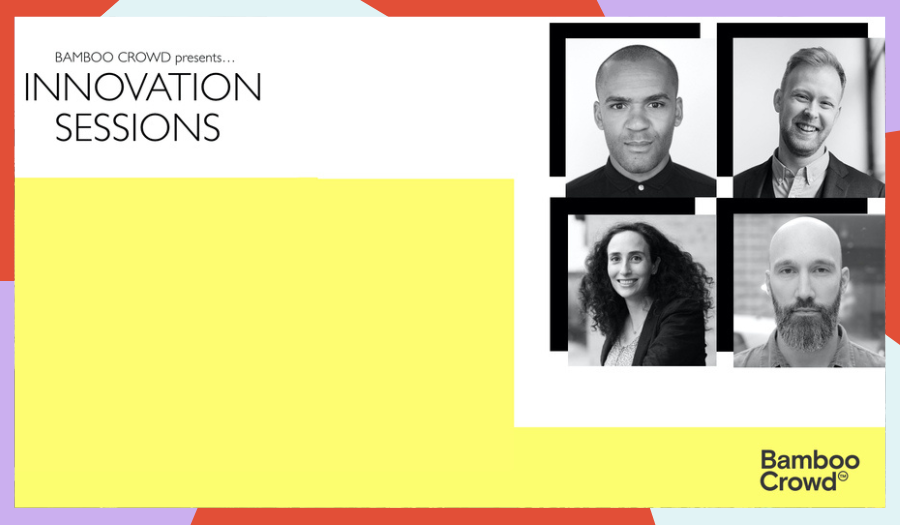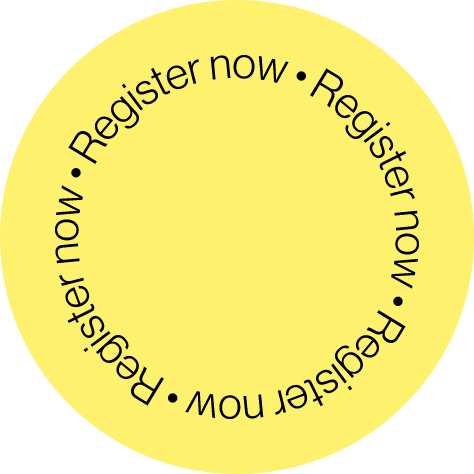4 exceptional panelists // 115 attendees // 5 questions
*Panel*
Alex Moseman // Director of Strategic Innovation, Samsung
Alain Sylvain // Founder & CEO, Sylvain Labs
Rachel Gordon // Entrepreneur In Residence, Highline Beta & former Global Innovation Director, PepsiCo
Otto Utti // Co-Founder & Managing Partner, Gemic
facilitated by Drew Welton // Co-Founder, Bamboo Crowd
Bamboo Crowd - EXPERT INNOVATION RECRUITER WITH OFFICES IN LONDON & NEW YORK - bringing innovation to life by hiring world-class talent - the people that develop game-changing products, services, experiences and cultures
*Setting the scene*
Behind the scenes there’s a seismic shift happening in the innovation space, where certain industries are hunkering down to fix/optimize the core business and have shelved innovation. BUT others have opportunistically (or have been forced to) capitalize on the momentum of this crisis to double down on their digital transformation.
*Session purpose*
The role of innovation in times of rapid change.
*Insight and Inspiration*
Q&A with our panel.
What are the different challenges industries are facing? Who will be the winners and losers looking at the shift from crisis mode to new normal?
Rachel – There are a lot of winners and losers but there are two industries in particular that are…both winners and losers. Healthcare… we know how [the pandemic] has been overloading the healthcare system causing massive strain, budgeting issues, etc… but at the same time as being a massive disaster it’s also triggered a huge amount of innovation around digital health, in particular. I heard the Head of CVS Health speak last week and he was talking about how there has been more innovation in digital health in the past 2 months then there was in the last 50 years which is a tremendous statistic.
The other industry that fits into this category is grocery and e-grocery. I think it’s obvious to all of us that people are now grocery shopping online more than ever, even people who resisted before. The paradox there is that it has been kind of a disaster as an experience for a lot of people in terms of unreliability, not being able to have things delivered when you want them, etc.
Alain – I do think it’s important to think about how there are losers across the board, even those companies thrust into hyper growth. On the surface that might look like [they are at an] advantage but, [growing so fast] often triggers some very impulsive decisions that aren’t necessarily healthy for the long-term health of the company.
For me [the winners] are really those companies who are willing to be courageous and invest in more offensive strategies, the ones that are willing to invest in innovation, R&D, and growth at this time. That is a brave decision and it makes me think about a great HBR article from a few years ago in the recession, where they pointed out that companies that invest in both offensive and defensive tactics in the midst of crisis are significantly more likely to outperform their competitors.
Alex – One of the big changes when we talk about the way the world was to the way the world is now is [the] big change from being more efficient, which was a core tenant for a lot of businesses in operational approaches, in product design, and even in strategic road mapping and thinking, to being more resilient and looking at larger ways of trying to improve. Not just in operational flow but in product mindset and product development and design and you are seeing that a lot in how companies are dealing with things like logistics and ways of working and I would say that absolutely, healthcare and grocery are beneficiaries… to changes in both physical infrastructure but also in technology infrastructure and logistics.
There is a lot of opportunity not just in terms of connecting route to market for product development, manufacturing, and consumer logistics, but also in helping people communicate better. A lot of the things that you are seeing around mutual aid networks, things that are coming out of the Black Lives Matter protests, and the way that people are sharing communications, sharing information, making it more transparent, but also more real time. This also starts to belie a new approach to how people are communicating effectively and not just efficiently.
Otto – Building on the ideas from Rachel and Alex…the platforms are going to become bigger, and we’ll move more and more into platform economics. I think one of the challenges that this poses to the more traditional players or to the players that don’t have these huge tech platforms, is the idea that it will become increasingly difficult for these businesses to compete or create value propositions if this infrastructure (in terms of supply chain, distribution marketing) is outdated.
It’s not enough for companies to have the best or the most purpose driven brand and user experience if you are not able to deliver that experience or product or service to customers to their preferred (and probably now more remote) locations. And so, what it really becomes about is… having a very up to-date infrastructure and having the right ecosystem players and partnerships, etc.
User experience or brand, in the traditional way that companies have been thinking about it, will no longer be a differentiator.
For me [the winners] are really those companies who are willing to be courageous and invest in more offensive strategies, the ones that are willing to invest in innovation, R&D, and growth at this time
Alain Sylvain
New sectors and businesses are created in times of change. During the 2008 recession there were a number of huge successes. From WhatsApp and Slack evolving the way we message each other, to Uber kick starting the gig economy. What new sectors do you see on the horizon?
Alain - The clear categories mentioned earlier are healthcare, grocery, and education. I think the nature of businesses related to work or co-working, or collaboration are posed for some significant growth as the nature of work is shifting so dramatically.
User experience or brand, in the traditional way that companies have been thinking about it, will no longer be a differentiator.
Otto Utti
How do diverse teams unlock new thinking and allow for innovation to thrive?
Otto- I think if we take a step back and think about what’s been clear for the last 20 years or more, the [innovation] teams whether client or agency, don’t and never really have reflected the diverse market or societies that they are innovating for. So, in addition to the moral aspect of companies wanting to be “on the right side of history”… there is also a clear business case for diversity and having more diverse teams.
The key question is, how do you get diverse teams to innovate at their best by making diverse teams?
Rachel- I think we need a greater degree of urgency around this and it is a topic we’ve been going around for a least the 15 years that I’ve worked in this space. I have an open call out to [the innovation space] on how we can make sure that this agenda gets prioritized. It has a direct impact on commercial success… it should be really urgent.
Alain – Language is important, and the phrase “diverse talent” implies that there is a leadership that looks out and the idea of diverse talent implies that others (people of color) are not at the very top. To prioritize diversity really means a reconstitution of the business and the way the business views the world so that it isn’t so much about diverse talent but it is about the best talent.
I think if we project the idea that we are looking to recruit diverse talent, that suggests that our perspective has always been limited. Maybe the way to look at talent it is more about looking for the best talent that reflects market opportunities or reflects the real world that we live in.
Alex – While we can all agree that attracting talent is important, part of the big reason why diversity has been very difficult to execute within innovation teams, client teams, and consultancies is because it is not just enough to attract them but you have to also be able to work with them in the way that they see fit. [For example] the softness of how people communicate when they come from different cultural backgrounds, come from different socioeconomic backgrounds, but also gender roles and certainly people with disabilities and how you actually account for that in the ways in which people work fundamentally changes the way in which you can attract talent. The biggest predictor of hiring is existing employees as they are usually the ones that attract through their network quality talent. But it’s not just enough to have people there…it’s actually more important to figure out good ways of work.
Alain – Poses a question: Do you believe that business metrics and performance is aligned with this new priority of diversity? Or do you think the performance of business truly prioritizes diversity in the way we talk about it?
Alex – I would say, yes and no – Absolutely it’s improved in the period that I’ve worked in the innovation space. Certainly, the fact that it’s being looked at and people are trying to actively engage more whether it’s in hiring metrics or in outcomes of work teams, or looking at new models for engaging with partners and vendors. It’s definitely moving in the right direction but it is not where it needs to be.
I think the difficulty is a lot of these types of things that we want to improve upon as we talk about diversity, cultural exchange, having a voice, psychological safety, is that these are difficult to measure empirically but are actually...valuable in terms of the outcome. We tend to measure effort instead of outcome.
To prioritize diversity really means a reconstitution of the business and the way the business views the world so that it isn’t so much about diverse talent but it is about the best talent.
Alain Sylvain
A shift from human-centered design to social-centered design. How is this changing the way you think and do?
Alex – The last decade was very profound in being able to drive the idea of human center design, moving away from one size fits all productization and trying to understand and uncover [consumers’] unmet needs and fulfill them in a niche way. This was hugely valuable but we are also getting to a turning point, we are seeing from a lot of different indicators that it’s not just about “how great can I be”, or “what are my needs”, or “how do I stand out, ” and actually there is huge value in local networks, whether it’s people, whether it’s just being able to get groceries, and being able to have healthcare locally. [Shifting from] looking at what’s not just good for individuals but what is good for societies whether that’s families, neighborhoods, and the idea of being able to rely on people around you.
How you can enable social connection and social opportunity is a differentiator that you’ll see play more and more as people look into innovation.
Otto – [Social centered design] is a logical outcome of this over individualized culture that we’ve been living in. Certainly seeing a shift towards this idea of not looking at people as individuals with individual outcomes and needs and aspirations, but as members of these larger interdependent systems where they are not driven by individual needs and motivations but they are members of a system in which the aspirations and ideals that drive people are a product of these larger cultural, societal and even technological forces. Overall moving the paradigm of analysis and the unit of analysis from individuals to systems and seeing people as actors within these systems. Then seeing that the outcomes [such as] products and services that brands deliver are not just the individualized outcomes but are collective outcomes.
Rachel – I wanted to mention one thing that has been apparent during the pandemic and it is this idea of cross-sector collaboration for innovation. In particular partnerships between NGOs, private sector, and the public sector. I think that this has taken the shape… [in an] emergency but I would hope that there is going to be more of an ecosystem type of approach and companies are going to find ways that they can actually have greater commercial impact by collaborating more with the public sector and with NGOs and really thinking big and thinking about communities. That can’t come from one company or one sector, everyone has to get involved which makes it more complex but also more impactful.
Alain – There is definitely the clear shift in how businesses are operating and they are starting to be more “promiscuous” with neighboring categories and neighboring sectors and they are starting to think about people as part of a bigger system.
What I think is very inspiring is that users are evolving in the same way that corporations are evolving and identifying with community more and more. I would say corporations have a unique role to play and so while it’s important for companies to project a sense of social centered design as they do innovation, it is also important to remember that people want it and are part of that fabric.
The last decade was very profound in being able to drive the idea of human center design, moving away from one size fits all productization and trying to understand and uncover [consumers’] unmet needs and fulfill them in a niche way.
Alex Moseman
How is the world of work changing? And as part of this, how is recruiting changing?
Rachel – I think one of the interesting shifts in hiring and working will be less based on physical proximity and I think there is going to be a lot more flexibility in people being based where they want to be. Which I think opens things a lot… And I think on a more emotional lens, the innovation work is going to be much more focused on people with common missions and a more networked economy. The networks that we currently have are going to become even more important and relationships will matter more than ever…and that is how you’ll get work and gigs.
On a practical basis… I think there is going to be more room for flexibility [in terms] more room for contractors and freelancers and interim work. And you might have shorter stints at more places.
Alex – One of the things that’s very difficult…is how you support those “happy accidents,” those little conversations in the hall…where you come up with a new opportunity or new thought, or new area of intrigue. The “happy accidents” are key to quality innovation but they are even more important to building those relationships and if people are short term or interim…as leadership are trying to build structure to support quality innovation, one of the fundamental things will be how do you have those moments that are structured around a specific moment or task…where you can get those little moments where people can build off ideas, come up with ideas, and challenge ideas? Trying to build that into the system when you are bringing in new people with different backgrounds and points of view is key, not just to getting the best out of people, but getting the best ideas into the mix so that people can play with them and test them, etc.
Alain – We are really thinking about what the future of work means to us [at Sylvain Labs] and thinking about what the meaning of our office space is… so we are thrust into a lot of those same conversations but, there is one thing that continues to hold true which is… there is an inherent human craving for intimacy as it relates to our work and our purpose and we as humans need to connect with others in a very real way. Our consulting work, when it comes to actually creativity requires a certain physical contact…to be at its best, it just does. And humans are ingenious, and we will find ways to approximate it. There is nothing that replaces the face-to-face, one-on-one contact and that is what I’m curious about. How are companies going to find ways to bring people together?... I believe there is a race to that because there is nothing that can replace it.
Otto – Yes, you can always do things more efficiently and you can work with clients do to things more digitally but nothing is even a close substitute for the serendipitous encounters at the office, being in the same space, having discussions that have nothing to do with work. So, really the question is what becomes the role of the office? And what does the new flexibility look like when you design an office.
The networks that we currently have are going to become even more important and relationships will matter more than ever…and that is how you’ll get work and gigs.
Rachel Gordon
Innovation Sessions is a monthly event with a simple purpose: Share insight and inspiration. We are always looking for innovation leaders who want to be part of the conversation. Get in touch with Drew drew@bamboocrowd.co.uk
Listen to the full event below!



